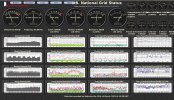Hull trains ordering 802 is a perfect example where bimodes make a lot of sense, as they can use the wires all the way up the ECML, then only switch to diesel on the unelectrified part. The branch to Hull will get wired eventually, but will never be at the top of the priority list, so would be several years away, even with a better rolling programme of wiring.
Hull is a good example.
The HT service isn't frequent enough to justify wiring the route north of Doncaster (and to get the benefit of allowing the Northern services from Doncaster to Hull to move to electric you'd have to wire both the "via Goole" and "via Selby" lines plus do the route from Doncaster to Sheffield... and if you're going to do all of that then you might as well do various other schemes... all of which pushes the price to an eye watering level that the Government won't want to pay for)
But order bi-modes and you've got a round trip of around three hundred and fifty miles on electric mode, remove a lot of air pollution from London, smoother journey etc
The alternative would be to trim such services back to (e.g.) London - Doncaster with passenger having to change for Hull (or to run diesels all the way into London)
I am disappointed that we find ourselves in a situation where bi-mode is considered necessary. I really feel that we should have had a greater proportion of our network wired by now than we have. However, this is where we find ourselves now
Ideally, we'd have wired every main line in a follow on from the WCML
But, since we didn't, how do we solve the fact that some busy main lines are still wire-free?
In the case of the MML, wiring all the way to Sheffield is too long term and too expensive for current politicians, but at least bi-modes can give us some benefits in the short term whilst providing some justification for piecemeal projects in the medium term (e.g. there's still some benefit to wiring as far as Leicester, then as far as Derby...)
If we wait for full electrification (and run pure diesels in the meantime) then we're going to be polluting the air a lot more than if we at least use electric mode on part of the journey
Over 10 years ago I predicted on this forum that bi-mode would be used as an excuse not to electrify, and this was borne out by the DfT who said that the use of bi-mode trains would mean that passengers would not have to put up with the inconvenience of electrification works
I think it's more a case that the GWML project was taking too much time and money, so bi-modes were a useful bit of PR to cover embarrassment.
But if we'd not had bi-modes then what would the solution have been? Cut the long distance services back to London - Didcot (just like the Oxford stoppers)? Or wire as far as Didcot before the money runs out and then continue running diesel trains all the way to London because we only want trains that are either "pure" diesel or "pure" electric?
What worries me is that the DfT lacks the strategic vision and will to actually do any of this stuff. As much as I agree with the supposition and theorising, the final say sits with the DfT and it is they, by their words and deeds, who will prove these theories and suppositions correct. Given their public pronouncements so far on the future of electrification and the role of bi- mode, I don’t hold out a lot of hope
The binary "diesel" / "electric" options mean that you are relying on some long term strategic plan with huge sums of money.
Based on Governments over my lifetime, I can't see any colour of party throwing such sums at the railway to do what you want (much as I'd like to believe it)
Bi-modes allow for smaller scale projects that still deliver some improvements and create some kind of virtuous circle (e.g. by the time you've wired the MML to Leicester then the cost of wiring Birmingham - Leicester becomes a lot cheaper since the hard work has already been done at the big stations, so all you're doing is the "countryside")
Whilst we wait for some enlightened Prime Minister who funds projects that will take a generation to deliver and gives the railway the kind of autonomy usually only found with Sir Topham Hat, we could be getting on with the kind of improvements that bi-modes permit, which deliver benefits much faster and can be targeted to deliver little wins around the country (instead of spending hundreds of millions of pounds in just one region - e.g. you could wire up a few key areas around the UK to remove diesel fumes from big cities and allow bi-mode trains to run on diesel through rural areas where air pollution is less of an issue)
You don't think that the Government has strategic vision, yet you are against the option that would allow us to improve things without requiring such forward thinking Government.
Don't forget freight. There is no option for heavy haul freight except electrification if it is inevitable that diesel traction has to end.
The problem I have with using freight as justification for electrification is that, even when there's a wholly wired freight flow, we often use diesels (sometimes because the flow interworks with other services, sometimes because it isn't worth having one electric loco dedicated to one flow)
Plus then there's the complication of wiring entire yards etc


